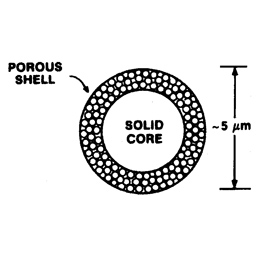Superficially porous particles with thicker outer shells were used extensively for liquid-liquid chromatography [1] and as the support for early bonded-phase packings in reverse phase HPLC [2].
Structure of particles
Nowadays superficially porous particles typically have a 5-µm solid core and a ~ 0.25 – 1 µm thick outer shell with 30-nm pores. But, the thinner the shell, the smaller is the particle surface area and the less is the sample loadability of these particles. Therefore, there must be a compromise between the thickness of the sh

ell to obtain good separation efficiency and good sample loadability. Thin porous shells lead to low surface areas, low retentivity, and low sample loadability; thicker shells of higher surface area produce higher retentivity and higher sample loadability.
Advantages
Superficial porous particles have unique characteristics that favour certain applications. Because of their size, macromolecules have very poor diffusional qualities. Therefore, the advantage is significant for the very short diffusional path lengths within the porous shell on the surface of superficial porous particles. Compared to conventional totally porous particles of the same size, superficial porous particles show improved mass-transfer kinetic properties that permit more rapid separations of macromolecules [3].
References
- J. J. Kirkland, Anal. Chem., 41 (1969) 218.
- J. J. Kirkland, J. J. DeStefano, J. Chromatogr. Sci., 8 (1970) 309.
- J. J. Kirkland, Anal. Chem., 64 (1992) 1239.